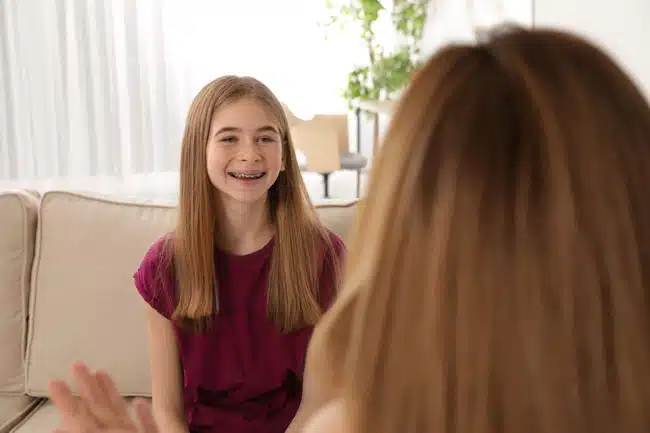As parents, you get used to the one-word answers we receive when asking our kids about their day. But what if there was a better way to engage? Psychologist Jennifer Busch from The Mindfull Project shares effective counselling micro skills that can foster better communication with your child, helping them feel heard, understood, and respected. Whether you’re dealing with school day stories or deeper concerns, these practical tips are a game-changer.
We’ve all been there:
“How was your day sweetheart?”
“Good.”
It’s hard to help your child or teen talk to you.
We know that continuing to prod our child by asking question after question usually shuts kids down further – but as parents, we struggle to work out what the alternative is. After all, don’t we want a meaningful and communicative relationship with our kid?
Counselling Micro Skills
Well, there is an alternative to the dead-end after school conversations. Learning about and using counselling micro skills. ‘Counselling micro skills’ is actually just a fancy phrase for how to really listen and draw out your child’s thoughts and feelings. Micro skills are actually the same skills psychologists are taught in their university training to assist in helping others open up to them.
Counselling micro skills have been shown to be incredibly useful in creating the right environment to help people (including your child!) feel heard, understood, and respected. When individuals feel understood and respected, they talk to you!
But first, it’s important to go into a conversation with your child with the right mindset! Frustration is the enemy of conversation because it creates impatience and judgement. This often creates a feeling of pressure, and we know kids hate pressure!
The kid conversation mindset involves three components:
Empathy
Empathy is paying attention to and trying to understand others’ feelings. Empathy is not over-identifying with your child’s feelings and becoming distressed yourself, rather, paying attention to their reactions.
Non-Judgemental Listening
Being able to listen attentively to your child without judgement, needing to impose your values, solutions, or making sure they understand what they did was wrong (that may come later!). Non-judgemental listening does not involve telling your child: ‘that was a foolish thing to do’, or ‘you let your friend down when you did that’.
Acceptance
An acceptance of your child- just as they are- including all their weaknesses, strengths, and choices they make. This does not mean that you need to agree or endorse their actions. You can take a curious attitude without having to agree with their behaviour.
This mindset will allow your child to feel they can be open with you without fear of being criticised.

Tips for getting your child to talk to you
These counselling micro skills are described below with some examples to help you start practising them in your own relationship with your child.
Active listening
Working to listen by staying focused on what your child is saying and remaining non-judgemental. This can involve using minimal encouragers such as ‘mmm’ (but not in a tone that conveys your opinion of the situation!). Another way to listen actively is (counterintuitively) to use silence. This means resisting the temptation to jump in and allowing the child’s thought processes to continue without interruption so they can keep speaking their mind to you.
Paraphrasing
Saying back what your child has said to you in your own words. For example:
“So, you are saying that Ellie didn’t play with you at lunchtime yesterday or today.”
You can turn these into a question by inflecting your voice up at the end of the sentence to check for understanding as well or add ‘Is that right?’ at the end of the sentence.
“So, you saw Jess steal some money out of Cooper’s bag and you think you want to tell the teacher tomorrow – is that right?”
In our example from the beginning of the article, we might say: “School was good”, and wait for them to say more.
Reflection of feelings
Another option is to restate or label the feelings your child is having to demonstrate understanding and acceptance. For example:
“It sounds as if you feel trapped in this friendship group.”
“I’m wondering if you are afraid of putting your hand up in class in case others laugh at you.”
“You feel conflicted because you like Ben, but he has been unkind to you every day this week which makes it hard to be his friend.”
Reflection of meaning
Looking beyond what your child says and identifying what it means to them. For example:
“Yelling in the playground is a way of coping with your feelings for you.”
“It’s scary to try in your test in case you fail, so you don’t complete the test to maintain your sense of self-worth.”
“It goes against your idea of being a good friend to stand by and watch Ruby say unkind things about Sienna.”
Reframing
Puts a different perspective on your child’s thoughts and feelings by looking at them from an alternate viewpoint. For example:
“Even though you feel very sad Adeline is refusing to talk to you, it sounds like now you can play with the friends who are nice to you at lunchtime.”
“You miss Mrs. Smith, but you are also saying you really like your new teacher as well.”
“You are worried about Billy’s behaviour, but you also can see Mr. Patterson is dealing with it in a kind but firm way.”
Open questioning
Questions that do not presume an answer but invites your child to speak more freely and openly. Usually involves asking ‘How, what, when, where why’. For example:
“How do you feel about that?”
“What would you like to see happen in this situation?”
“What is the most difficult part about playing with Harrison at lunch?”
Summarising
Picks out salient points and common threads, draws them together and presents them to your child in a clear and precise way. This helps if the child is stuck, or you are trying to focus the conversation. For example:
“From what you’ve said so far, it seems like you are often on your own in the playground and you don’t like that.”
Challenging
This is an advanced skill! Gently highlighting inconsistencies in your child’s situation, words, or feelings. Proceed with gentleness! Teens especially can get defensive if they feel undermined by your challenge. Some good examples:
“You are concerned that Savannah isn’t eating any of her lunch every day, but you are also telling me you don’t want to ask her about it or tell the teacher.”
“You don’t believe Kim would hurt you, yet you sound really worried when you talk about it.”
“You say you want to work things out with James, but it also seems like you’re avoiding him at school.”
A final note, these skills take practice! But they are absolutely possible to build in your relationship with your child. Hear me when I tell you the payoffs with your child are worth the persistence!
If reading all these skills at once leaves you feeling overwhelmed as to how to implement them with your child, just pick one. These skills are also often best learnt via demonstration or observation, so a quick search on YouTube to see demonstrations of specific skills can be very helpful. I hope this gives you some direction in helping your child open up to you enroute to creating the meaningful relationship you want to have with your child.












